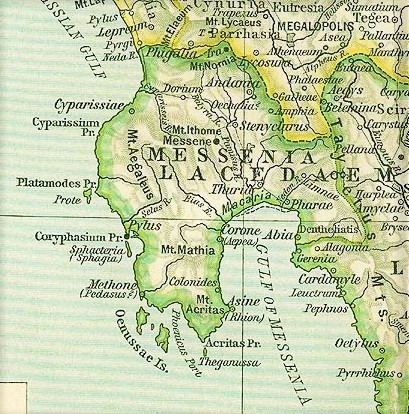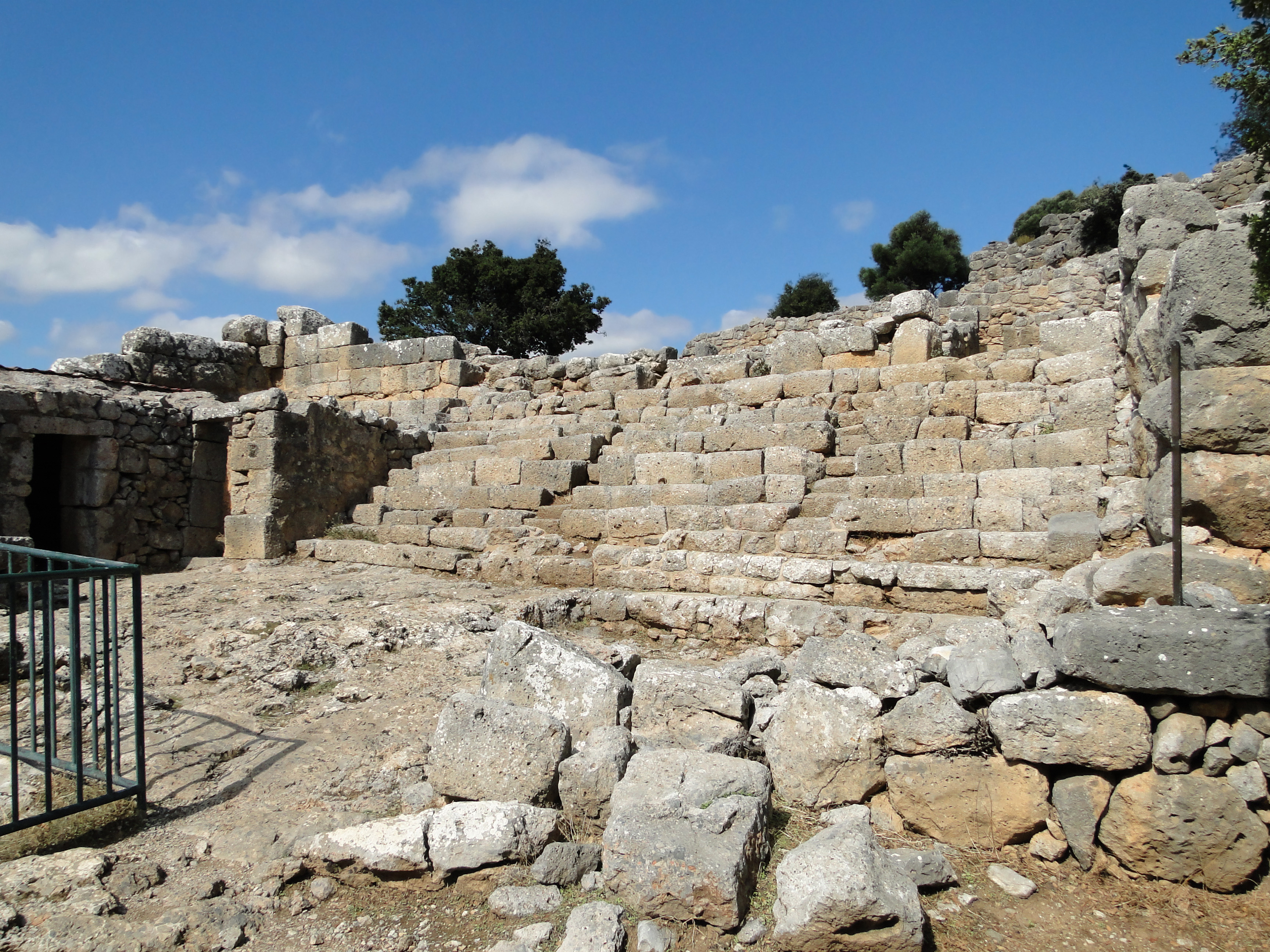|
Messenia (ancient Region)
Messenia or Messinia ( el, Μεσσηνία) was an ancient district of the southwestern Peloponnese, more or less overlapping the modern Messenia region of Greece. To the north it had a border with Elis along the Neda river. From there the border with Arcadia ran along the tops of Mount Elaeum and Mount Nomia and then through foothills of Taygetus. The eastern border with Laconia went along the Taygetus ridge up to the Koskaraka river, and then along that river to the sea, near the city of Abia. Ancient Messenia descended continuously without change of name and with little change of territory to the modern Regional Unit of Greece of the same name. History Bronze age The earliest inhabitants of Messenia were thought by the Greeks of the Classical period to have been 'Pelasgians', as in other regions of Greece. Supposedly, the Hellenic tribes had then arrived in Greece, and Messenia was settled by Aeolian Greeks. The Mycenaean city of Pylos has been identified with the modern ... [...More Info...] [...Related Items...] OR: [Wikipedia] [Google] [Baidu] |
Ancient Greece
Ancient Greece ( el, Ἑλλάς, Hellás) was a northeastern Mediterranean civilization, existing from the Greek Dark Ages of the 12th–9th centuries BC to the end of classical antiquity ( AD 600), that comprised a loose collection of culturally and linguistically related city-states and other territories. Most of these regions were officially unified only once, for 13 years, under Alexander the Great's empire from 336 to 323 BC (though this excludes a number of Greek city-states free from Alexander's jurisdiction in the western Mediterranean, around the Black Sea, Cyprus, and Cyrenaica). In Western history, the era of classical antiquity was immediately followed by the Early Middle Ages and the Byzantine period. Roughly three centuries after the Late Bronze Age collapse of Mycenaean Greece, Greek urban poleis began to form in the 8th century BC, ushering in the Archaic period and the colonization of the Mediterranean Basin. This was followed by the age of Classical G ... [...More Info...] [...Related Items...] OR: [Wikipedia] [Google] [Baidu] |
Nichoria
Nichoria ( el, Νιχώρια) is a site in Messenia, on a ridgetop near modern Rizomylos, at the northwestern corner of the Messenian Gulf. From the Middle to Late Bronze Age it cultivated olive and terebinth for export.Palaima (2000), p. 17. During the Helladic period it was part of the Mycenaean civilisation. Nichoria reached its greatest extent (5 hectares) in LHIIIA:2, and even sported a royal Pylos-style megaron; although it was always smaller. Nichoria became subordinate to Pylos and lost the use of its megaron.Davis and Alcock (1998), pp. 127-128. Toward the end of LH IIIB, the palace at Pylos knew Nichoria under the name of TI-MI-TO A-KO.Shelmerdine (1981). Nichoria was a major outpost of Pylos's "Trans-Aigolaia" province. According to Palaima, "it occurs on ten tablets that relate to: bronze working, six standard items of regional taxation, bronze recycling for weaponry production, coastal defensive arrangements, gold, landholdings, livestock, male personnel, and rather i ... [...More Info...] [...Related Items...] OR: [Wikipedia] [Google] [Baidu] |
Aristodemus Of Messenia
In Greek mythology, Aristodemus (Ancient Greek: Ἀριστόδημος) was one of the Heracleidae, son of Aristomachus and brother of Cresphontes and Temenus. He was a great-great-grandson of Heracles and helped lead the fifth and final attack on Mycenae in the Peloponnese. Aristodemus and his brothers complained to the oracle that its instructions had proved fatal to those who had followed them; the oracle had told Hyllas to attack through the narrow passage when the third fruit was ripe. They received the answer that by the "third fruit" the "third generation" was meant, and that the "narrow passage" was not the isthmus of Corinth, but the straits of Rhium. They accordingly built a fleet at Naupactus, but before they set sail, Aristodemus was struck by lightning (or shot by Apollo) and the fleet destroyed, because one of the Heraclidae had slain an Acarnanian soothsayer. His brothers were later able to conquer the Peloponnese. By his wife Argia, daughter of King Autesion ... [...More Info...] [...Related Items...] OR: [Wikipedia] [Google] [Baidu] |
Teleclus
Teleclus or Teleklos (Greek: Τήλεκλος) was the 8th Agiad dynasty king of Sparta during the eighth century BC. He was the son of King Archelaus and grandson of King Agesilaus I. Pausanias reports that Teleclus' reign saw the conquest of Amyclae, Pharis and Geranthrae, towns of the Perioeci or "dwellers round about". Teleclus was killed during a skirmish with the Messanians during a festival at the temple of Artemis Limnatis, Pausanias 1918 Book 4, IV, 1-3. an event foreshadowing the First Messenian War. He was succeeded by his son Alcmenes Alcmenes ( grc-gre, Ἀλκμένης) or Alcamenes, Alkamenos, was the 9th king of Sparta of the Agiad dynasty, from c. 740 to c. 700 BC. According to Pausanias, he was a commander in the night-expedition against Ampheia, which began the First M .... Notes References * 8th-century BC rulers 8th-century BC Spartans Agiad kings of Sparta Ancient Greeks killed in battle 8th-century BC deaths Year of birth unknown Mo ... [...More Info...] [...Related Items...] OR: [Wikipedia] [Google] [Baidu] |
First Messenian War
The First Messenian War was a war between Messenia and Sparta. It began in 743 BC and ended in 724 BC, according to the dates given by Pausanias (geographer), Pausanias. The war continued the rivalry between the Achaeans (tribe), Achaeans and the Dorians that had been initiated by the purported Return of the Heracleidae. Both sides utilized an explosive incident to settle the rivalry by full-scale war. The war was prolonged into 20 years. The result was a Spartan victory. Messenia was depopulated by emigration of the Achaeans to other states. Those who did not emigrate were reduced socially to helots, or serfs. Their descendants were held in hereditary servitude for centuries until the Spartan state finally needed them for defense. Dates Pausanias' standard dates Pausanias (geographer), Pausanias says that the opening campaign was a surprise attack on Ampheia by a Spartan force commanded by Alcmenes, List of kings of Sparta#Agiad dynasty, Agiad king of Sparta, in the second yea ... [...More Info...] [...Related Items...] OR: [Wikipedia] [Google] [Baidu] |
Sparta
Sparta ( Doric Greek: Σπάρτα, ''Spártā''; Attic Greek: Σπάρτη, ''Spártē'') was a prominent city-state in Laconia, in ancient Greece. In antiquity, the city-state was known as Lacedaemon (, ), while the name Sparta referred to its main settlement on the banks of the Eurotas River in Laconia, in south-eastern Peloponnese. Around 650 BC, it rose to become the dominant military land-power in ancient Greece. Given its military pre-eminence, Sparta was recognized as the leading force of the unified Greek military during the Greco-Persian Wars, in rivalry with the rising naval power of Athens. Sparta was the principal enemy of Athens during the Peloponnesian War (431–404 BC), from which it emerged victorious after the Battle of Aegospotami. The decisive Battle of Leuctra in 371 BC ended the Spartan hegemony, although the city-state maintained its political independence until its forced integration into the Achaean League in 192 BC. The city nevertheless ... [...More Info...] [...Related Items...] OR: [Wikipedia] [Google] [Baidu] |
Stenyclarus
Stenyclarus or Stenyklaros ( grc, Στενύκλαρος), or Stenyclerus or Stenykleros (Στενύκληρος), was a town in the north of ancient Messenia, and the capital of the Dorian conquerors, built by Cresphontes. Andania Andania ( el, Ανδανία) is a former municipality in Messenia, Peloponnese, Greece. Since the 2011 local government reform it is part of the municipality Oichalia, of which it is a municipal unit. The municipal unit has an area of 88.694& ... had been the ancient capital of the country. The town afterwards ceased to exist, but its name was given to the northern of the two Messenian plains. References Populated places in ancient Messenia Former populated places in Greece Lost ancient cities and towns {{AncientMessenia-geo-stub ... [...More Info...] [...Related Items...] OR: [Wikipedia] [Google] [Baidu] |
Cresphontes
In Greek mythology, Cresphontes (; grc, Κρεσφόντης) was a son of Aristomachus, husband of Merope, father of Aepytus and brother of Temenus and Aristodemus. He was a great-great-grandson of Heracles and helped lead the fifth and final attack on Mycenae in the Peloponnesus. He became king of Messene. Cresphontes and his brothers complained to the oracle that its instructions had proved fatal to those who had followed them (the oracle had told Hyllus to attack through the narrow passage when the third fruit was ripe). They received the answer that by the "third fruit" the "third generation" was meant, and that the "narrow passage" was not the isthmus of Corinth, but the straits of Rhium. They accordingly built a fleet at Naupactus, but before they set sail, Aristodemus was struck by lightning (or shot by Apollo) and the fleet destroyed, because one of the Heraclidae had slain an Acarnanian soothsayer. The oracle, being again consulted by Temenus, bade him offer an ... [...More Info...] [...Related Items...] OR: [Wikipedia] [Google] [Baidu] |
Dorians
The Dorians (; el, Δωριεῖς, ''Dōrieîs'', singular , ''Dōrieús'') were one of the four major ethnic groups into which the Hellenes (or Greeks) of Classical Greece divided themselves (along with the Aeolians, Achaeans, and Ionians). They are almost always referred to as just "the Dorians", as they are called in the earliest literary mention of them in the ''Odyssey'', where they already can be found inhabiting the island of Crete. They were diverse in way of life and social organization, varying from the populous trade center of the city of Corinth, known for its ornate style in art and architecture, to the isolationist, military state of Sparta. And yet, all Hellenes knew which localities were Dorian, and which were not. Dorian states at war could more likely, but not always, count on the assistance of other Dorian states. Dorians were distinguished by the Doric Greek dialect and by characteristic social and historical traditions. In the 5th century BC, Dorians an ... [...More Info...] [...Related Items...] OR: [Wikipedia] [Google] [Baidu] |
Greek Dark Ages
The term Greek Dark Ages refers to the period of Greek history from the end of the Mycenaean palatial civilization, around 1100 BC, to the beginning of the Archaic age, around 750 BC. Archaeological evidence shows a widespread collapse of Bronze Age civilization in the Eastern Mediterranean world at the outset of the period, as the great palaces and cities of the Mycenaeans were destroyed or abandoned. At about the same time, the Hittite civilization suffered serious disruption, as cities from Troy to Gaza were destroyed. In Egypt, the New Kingdom fell into disarray, which led to the Third Intermediate Period of Egypt. Following the collapse, fewer, smaller settlements suggest extensive famine and depopulation. In Greece, the Linear B script used by Mycenaean bureaucrats to write the Greek language ceased, with the Greek alphabet not developing until the beginning of the Archaic Period. The decoration on Greek pottery after about 1100 BC lacks the figurative d ... [...More Info...] [...Related Items...] OR: [Wikipedia] [Google] [Baidu] |
.jpg)



